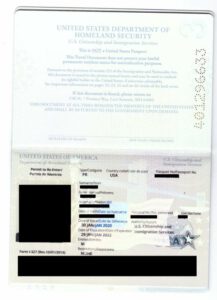Returning Resident Visa
If you have been absent from the U.S. for one year or longer, you might be considered to have abandoned your status as a legal permanent resident (LPR) and your green card might no longer be valid. Customs and Border Protection (CBP) officers at the border of the U.S. may not allow you to enter the U.S., or alternatively the CBP officer could allow you to enter, but also refer your case to the immigration court to start legal proceedings to remove your legal permanent status. To avoid this, a returning Resident Visa may be available to some permanent residents that found themselves in extraordinary situations.
There is a variety of scenarios that could leave you stranded abroad and justify your long absence from the US. Here are some potential solutions to your situation.
Temporary Absence of Less Than One Year (Lost Green Card)
Legal permanent residents who lose their green card while outside the United States can return to the US. The legal permanent resident first must file an applicant for a travel document (Form I-131A) at the closest U.S. embassy or consulate. The application for a travel document can only be filed if you are returning from overseas travel of:
- Less than one year, and your green card has been lost, stolen or destroyed; or
- Less than two years, and your Re-entry permit has been lost, stolen or destroyed.
Temporary Absence of More Than One Year
An absence of more than one year can make things more complex for a legal permanent resident. Even if the LPR has a green card, the CBP officers will likely ask a series of questions to determine if the absence was temporary in nature. A legal permanent resident who has been living outside the United States will likely be referred to an immigration court for immigration proceedings. This is a serious matter. An immigration judge will decide if you have abandoned your legal permanent resident status.
This problem can be avoided by obtaining a Re-entry permit before departing the United States. A re-entry Permit is valid for entry to the United States for a period of up to two years. However, if you didn’t have a re-entry permit in hand and you still want to live in the US, you should seriously consider applying for a Returning Resident Visa.
Returning Resident Visa – Temporary Absence of More Than One Year
As explained above, a legal permanent resident who remained outside the United States for longer than one year, or beyond the validity period of a re-entry permit, will require a new immigrant visa to enter the United States and resume permanent residence. A provision exists under the U.S. law for the issuance of a returning resident visa to an LPR (Legal Permanent Resident) who remained outside the United States due to circumstances beyond his/her control.
If an LPR was unable to return to the United States within the maximum travel validity period of a green card (less than 1 year) or the maximum validity of the Re-entry Permit (up to 2 years), he can apply at the nearest U.S. Embassy for a Returning Resident (SB-1) immigrant visa.
If the application for returning resident status is approved, it eliminates the requirement that an immigrant visa petition be filed on your behalf with the U.S. Citizenship and Immigration Services (USCIS).
An applicant for Returning Resident Visa is required to establish eligibility for an immigrant visa
Qualifying for Returning Resident Status
To qualify for returning resident status, you will need to prove to the Consular Officer that you:
- Had the status of a legal permanent resident at the time of departure from the United States.
- Departed from the United States with the intention of returning and have not abandoned this intention.
- Is returning to the United States from a temporary visit abroad and, if the stay abroad was protracted, this was caused by reasons beyond your control and for which you were not responsible.
Applying for a Returning Resident Visa
An applicant should contact the nearest U.S. Embassy in advance of his intended travel (at least 6-12 months in advance, if possible) to permit sufficient time for visa processing. As part of the visa application process, an interview at the U.S. Embassy is required.
Required Documentation
When applying for a Returning Resident immigrant visa, an applicant should submit the following forms and documents to the U.S. Embassy or Consulate:
- A completed application to determine Returning Resident status (Form DS-117)
- His/her Permanent Resident Card, Form I-551
- His/her Re-entry Permit, if available
In addition, the applicant must also submit supporting documents that show the following:
- Dates of travel outside of the United States (Examples: airline tickets, passport stamps, etc.)
- Proof of his ties to the United States and his intention to return (Examples: tax returns, and evidence of economic, family and social ties to the United States)
- Proof that his protracted stay outside of the United States was for reasons beyond his/her control (Examples: medical incapacitation, employment with a U.S. company, etc.)
After submitting the application, a consular officer will review the application and supporting documents to determine whether the applicant meets the criteria for a Returning Resident status. The applicant must be eligible for the immigrant visa in all other respects before he/she is issued a Returning Resident immigrant visa.
All said and explained in this article does not constitute a legal opinion and does not replace legal advice. Responsibility for using the wordings and opinions conveyed in this article relies solely and entirely on the reader.
This article was written by Dotan Cohen Law Offices, working in the field of immigration law in Israel, the United States and Canada.



